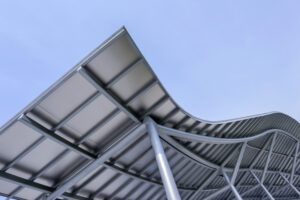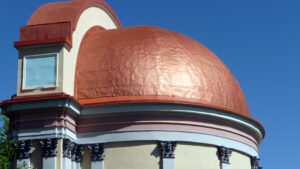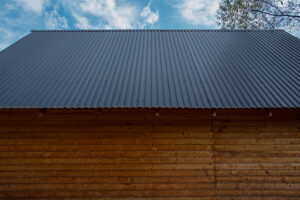Contents [show table of contents]
Metal roofs are simply roofing materials made from metals such as steel, tin, zinc, or copper. They provide an alternative to concrete tiles, asphalt shingles, or wood shakes. Whether you are a novice looking for the appropriate roof for your home or are a professional looking to learn about metal roofs in detail, this article will answer all potential questions you may have.
Contents
- Types of Metal roofs
- Advantages and Disadvantages of Metal roofs
- Cost of Metal roofs
- Conclusion
Types of Metal roofs
Metal roofs are some of the most commonly used roofs in the world today. They are available in a variety of options depending on what metals are combined to make the roofing sheets. They have different costs, and the required applications determine the most appropriate option.
Aluminum Roof
Although aluminum roofs are very lightweight, they are equally durable and can withstand adverse conditions.
They are ideal for use in coastal regions since aluminum is resistant to salts that cause other metal roof types to rust. Aluminum reacts with oxygen to form an aluminum oxide layer which keeps it inert to corrosive salts. This makes them good for use in industrial areas such as factories which release gaseous wastes into the atmosphere.

Also, aluminum offers a lightweight option for buildings that require lesser loads from the roofing. This reduction can prove significant when the structure covers larger areas and needs more roofing sheets.
However, aluminum roofs are slightly more expensive than copper roofs due to their relatively lightweight and resistance to adverse atmospheric conditions. They are more economical as their resistance makes them last much longer.
Aluminum roofs can also get dented more easily than other roofs. This is important in regions where regular hailstone or materials is falling onto the roof. This can be mitigated by increasing the thickness of the sheets.
Zinc Roof
Zinc roofs have a striking appearance but tend to change color (or patina) over time. This patination signifies the development of a zinc carbonate protective layer to withstand atmospheric conditions but alters the color of the roofing panels into a blue/grey patina.
These patinas are very important as they provide zinc roofs with self-healing properties that help heal scratches on their surface over time.

Zinc roofs are suited for use in commercial projects as they can be easily formed and manipulated into varying shapes thanks to the lower melting point of zinc.
They are highly durable, thus an economic choice for long-term roofing needs. Due to their low melting point, the production of zinc roofs uses less energy. They are also 100% recyclable making them very eco-friendly.
Steel Roof
Steel is an alloy of different elements mainly iron, carbon, and other elements in trace amounts. Steel is an essential construction material with numerous uses. Steel is now commonly used as a roofing material and is used increasingly in residential houses.

Steel is highly recyclable and is the most recycled metal in the world today. Due to its ready availability, the cost of a steel roof is lesser than most other metal roof types that are not as ubiquitous.
Another reason for the prevalence of steel is its flexibility. Steel can be modified in several ways as the need to be made of it.
When steel is coated with Zinc, galvanized steel is produced. The coating provides the steel with a layer of protection from corrosion. If steel is coated with Aluminum and Zinc, Galvalume steel is produced. This offers better protection than galvanized steel in certain conditions. Steel roofs have high strengths and are largely immune to damages from denting.
Copper Roof
Copper roofs are the oldest form of metal roofing. They have been used for several decades the world over. Copper roofs tend to also patina and change color over time into a brown patina color.
It can last for as much as a century if it is installed and maintained properly. Copper roofs tend to be expensive and are rarely utilized for expansive roofing projects but smaller structures.

Due to copper’s relative softness, copper roofs are not ideal for locations where roofs may be dented or impacted by hard or sharp materials. Also, copper is not as widely available as other metal types due to cost reasons. Copper roofs are also recyclable making them highly eco-friendly.
Tin Roof
Tin roofs are the least common of the metal roofing options. Generally, tin roofing is mostly rolled steel coated with tin. Tin roofing was more popular in the 19th century, but since the advent of aluminum roofs, tin roofs have experienced a decline and are now scarcely found.

Tin roofs are lightweight and much easier to install. This is the reason why the use of tin roofs was widespread in rural America. Rural dwellers simply used tin cans they had flattened out as roofing sheets for their roofing needs.
Advantages and Disadvantages of Metal Roofs
The advantages and disadvantages of metal roofs are numerous. While the advantages far outweigh the disadvantages, it is necessary to be well informed before choosing a type of roof.
Advantages
There are several reasons why the use of metal roofs has experienced a continuous increase over the decades, some of these include.
Ease and Speed of Installation
Metal roofs are sold in large sheets in sizes between 12 to 36 inches in width and 6 to 16 ft in length. These sections can easily be attached to other sections, and the roofing is completed quickly. This is particularly important in emergencies where the existing roof is pulled down due to strong winds or some other factors.
Fire and Heat Resistance.
Metal surfaces are typically reflectors of radiant heat from the sun. This property means less energy is required for cooling with an air conditioner thus making them cost-friendly.
Also, metal roofs are non-combustible. You are assured that in the event of a fire outbreak, the roof will not contribute further fuel to the already raging fire. Metal roofs are typically classified as Class A fire-resistant meaning they are highly resistant to fire.
Durability
If properly installed, metal roofs can last for several decades. Metals can withstand the adverse atmospheric effects posed by climatic factors such as sun, rain, snow, winds, etc.
Metals are impervious to water if joined with the required lap lengths and can withstand wind storms of over 100 mph. Of all the other roofing materials, metals are the most durable of the lot.
Economy
While the cost of purchase and installation of metal roofs can be high initially, their usage is still economical nonetheless. This economy is because the cost of maintenance and repairs for metal roofs is very low or non-existent.
Using another type of roof such as asphalt shingle will require periodic maintenance and won’t last as long. The cost of replacing the asphalt roof repeatedly over the lifespan of the metal roof also adds up to the costs incurred.
Environmentally Friendly
Metal roofs are eco-friendly for three main reasons. Firstly, they are produced from recycled materials, reducing the amount of new material required. Secondly, all types of metal roofs are recyclable.
At the end of their productive lives, metal roofs can be transformed into other new materials or reproduced to obtain new roofing metals. Finally, since they can last several times longer than other materials, they don’t have to be disposed of, unlike other materials.
Lightweight
Compared to other roof types, metal roofs are lighter and require fewer structural supports. Metal roofs weigh 1 to 3 pounds/ft2 depending on the thickness as compared to other roof types which weigh as much as 5 pounds/ft2 or more.
This lightweight can provide economy when designing the structural supports as lesser loads from the roof translate to smaller section sizes and a lesser number of supports.
Disadvantages
Cost
Perhaps, the biggest drawback about metal roofs is the high cost of purchase and installation required initially. Metal roofs are an investment that will take time before reaching maturity.
Such an investment may not make much sense if one erects a metal roof in a building one plans to stay temporarily. However, for a family home, metal roofs are a good investment.
Indentation
Metal roofs may tend to dent more depending on the type of metal and the thickness of the roof panels. In extreme impact zones such as large hailstones or indenting from falling objects, metal roofs may be dented or even get punctured. However, to a large extent, metal roofs resist denting from impacting objects.
Requires professional installation
Though metal roofs are durable and can last for several years, their longevity is very much proportional to the adequacy of their installation. Their installation requires professionals trained to safely and properly carry out the installation.
Individual panels must lap appropriately, and care must be taken at the joints as those could pose the biggest challenges in the future. This installation required attracts additional costs separate from the purchase cost.
Cost of Metal Roofs
Different factors affect the cost of setting up a metal roof. The costs vary depending on the type of metal roofs which also determine the costs of installation, the panel profile, color, size of the roofing job, and fluctuations in prices of metals.
Cost due to type of roof and installation required
These two are very closely associated and most often go together. Typically, steel is the cheapest and costs around $3/ft2 and costs about $15,000 on average for installation. Aluminum costs a little over $3/ft2 and costs about $20000 to install. Copper roofs are typically the most expensive of metal roofs.
The cost per square foot is usually over $10 and can be as high as $20. The installation price is also higher than other alternative metal roofs and can be as high as $50000. Other metal roof types range between steel and aluminum and copper, with copper being the most expensive.
Cost due to Panel profile
Depending on the thickness of the panels, and the type of fastener in the roof panels, the cost of metal roofs also varies. Metal roof thicknesses usually come in decreasing gauges from 29 to 20. 29 gauge thickness is light while 20 gauge is heavy.
The most commonly used is 26 gauge and 24 gauge. 20 gauge thickness is about 0.375 inches thick, while 29 gauge is about 0.14 inches thick. Differences in price between 24 gauge and 26 gauge panels are as high as $1/ ft2 in some instances. Rarer thicknesses may be more expensive depending on the availability.
Also, PVDF paint finishes are typically used for thicknesses and cost more than SMP finishes used for lighter panels. Another factor inherent to panel profiles is the nature of the fastener used. Exposed fasteners are much cheaper than concealed fastener types.
Cost due to the size of the roofing
Generally, larger roofing jobs are more economical on the price of materials and installation than smaller jobs. Jobs over 5000 square feet are big and will cost lesser per square foot than a job that is less than 1000 square feet.
The differences between these two categories can be as high as 20% variation on the smaller jobs. Jobs greater than 1000 square feet will have a lesser variation compared to those lesser than 1000.
Fluctuations of metal prices
Since metals are used for many other functions, their prices vary based on demand and supply. When a particular metal, for example, aluminum that is used in electronics is in high demand, the prices of aluminum roofing sheets may increase and vice-versa when it is abundant.
Similar relationships exist for steel which is also heavily utilized for building construction and the other metals which have alternative uses.
Color
Metal roofs are available in a variety of colors depending on the finishing paint which coats the external surface. There are various types like standard colors, specialty paint finishes among others. You can choose your desired color as different hues ranging from more earthy and warmer tones to brighter colorful tones are available.
The more commonly used colors are cheaper than the rarer colors which have to be ordered specially from the roof manufacturer.
Conclusion
Overall, metal roofs provide a bespoke finish to any housing project. With a variety of options to choose from, there is the perfect roof for everybody. Metal roofs are guaranteed to last over 5 decades and require minimum maintenance if installed properly. Metal roofs are a prudent investment, every homeowner will be grateful to have undertaken.

18 thoughts on “metal roofs: a cheat-sheet for the most popular roof!”
Comments are closed.